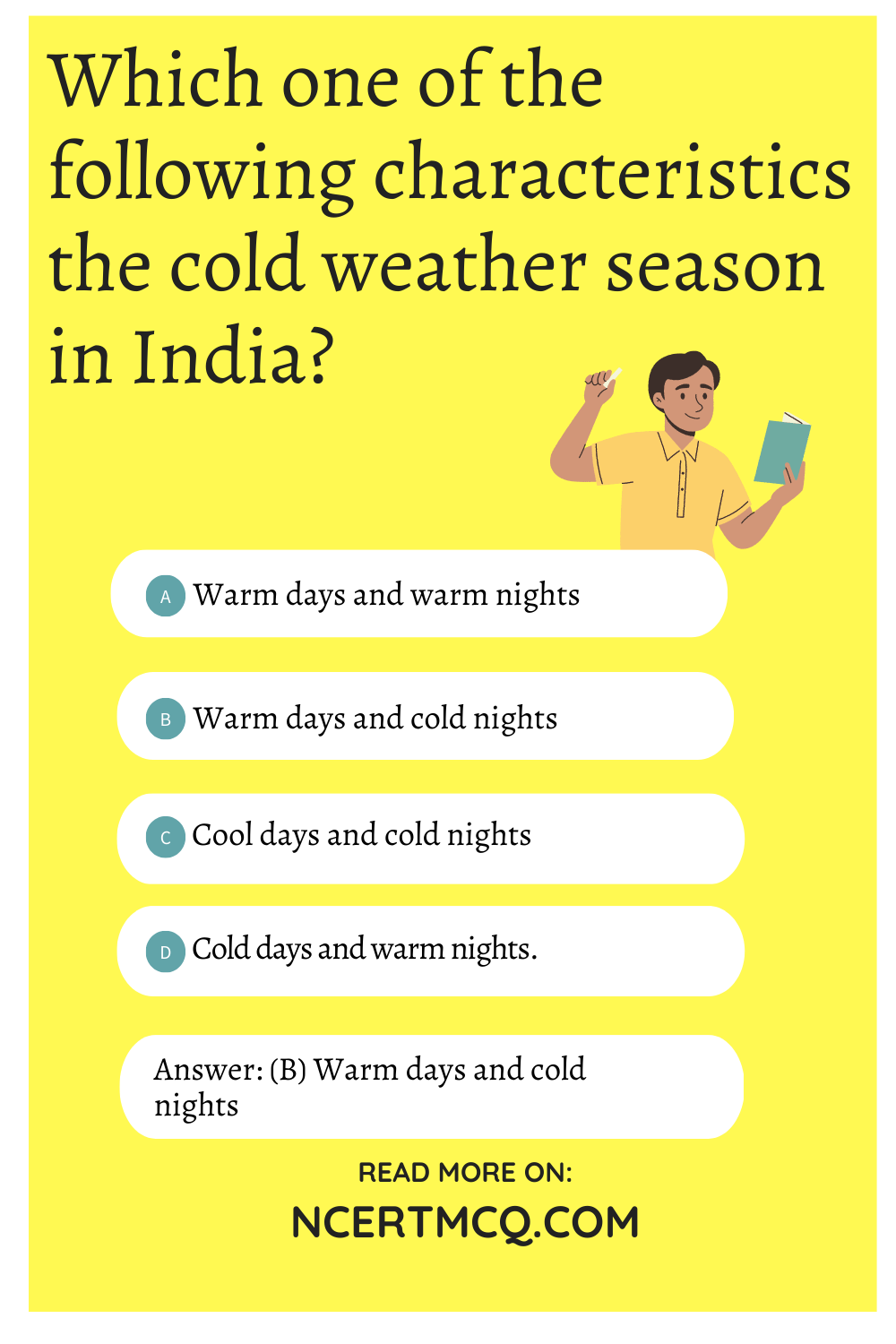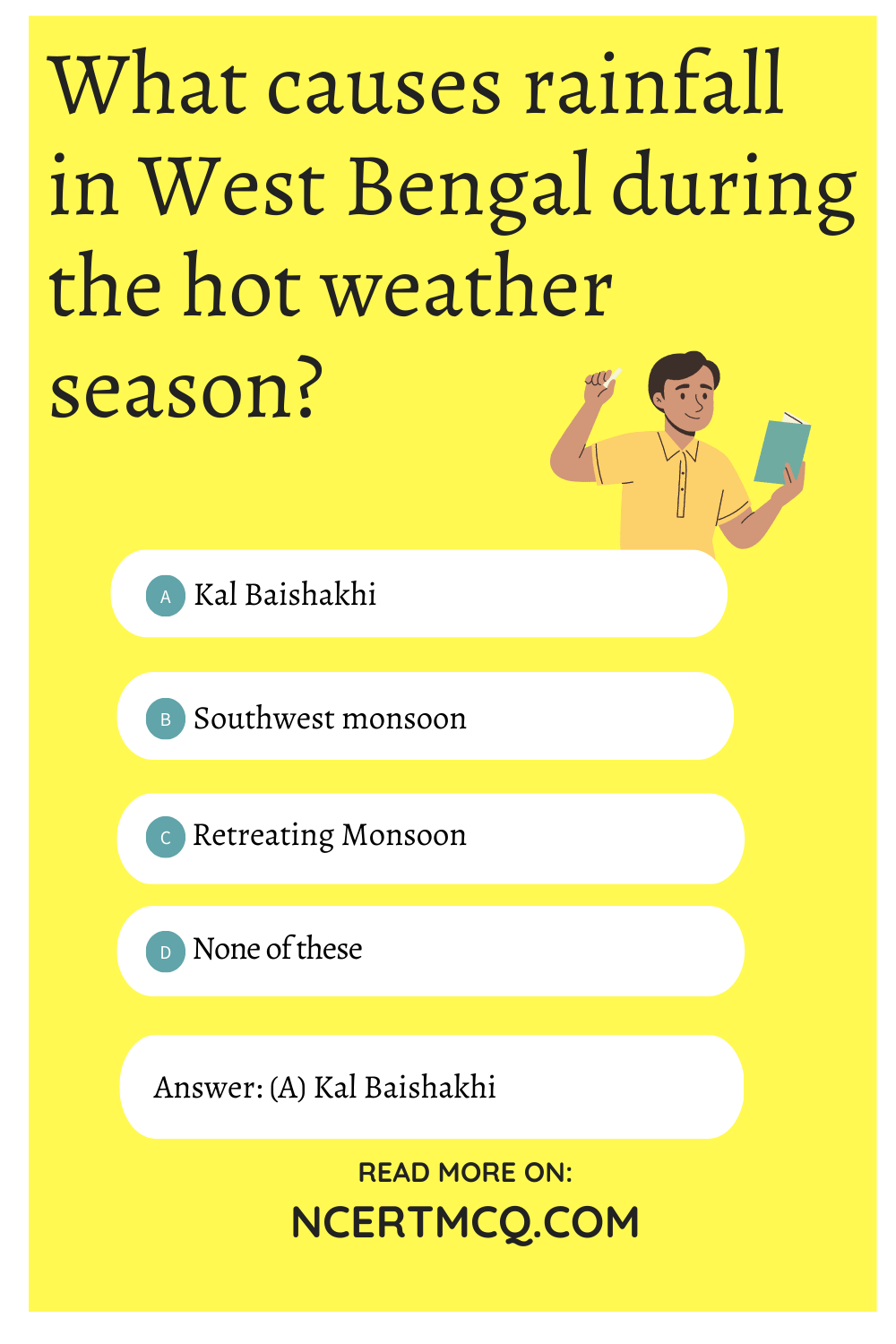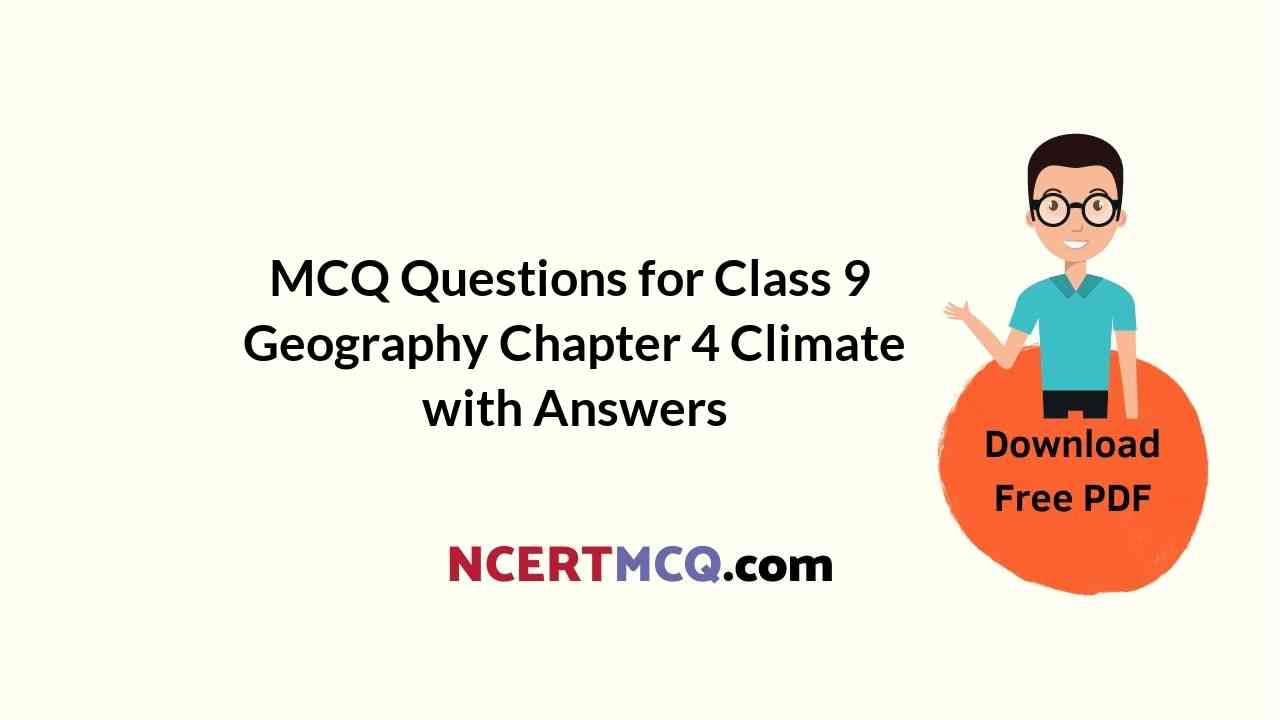Check the below NCERT MCQ Questions for Class 9 Geography Chapter 4 Climate with Answers Pdf free download. MCQ Questions for Class 9 Social Science with Answers were prepared based on the latest exam pattern. We have Provided Climate Class 9 Geography MCQs Questions with Answers to help students understand the concept very well. https://ncertmcq.com/mcq-questions-for-class-9-social-science-with-answers/
Class 9 Social Science Geography Chapter 4 MCQ With Answers
Geography Class 9 Chapter 4 MCQs On Climate
Choose the correct option:
Climate Class 9 MCQ Chapter 4 Question 1.
Which one of the following places receives the highest rainfall in the world?
(a) Silchar
(b) Mawsynram
(c) Cherrapunji
(d) Guwahati
Answer
Answer: (b) Mawsynram
Climate MCQ Class 9 Chapter 4 Question 2.
The wind blowing in the northern plains in summers in known as:
(a) Kaal Baisakhi
(b) Loo
(c) Trade winds
(d) None of the above
Answer
Answer: (b) Loo
Class 9 Climate MCQ Chapter 4 Question 3.
Which one of the following causes rainfall during winters in north-western part of India?
(a) Cyclonic depression
(b) Retreating monsoon
(c) Western disturbances
(d) Southwest monsoon
Answer
Answer: (c) Western disturbances
Class 9 Geography Chapter 4 MCQ With Answers Question 4.
Monsoon arrives in India approximately in:
(a) Early May
(b) Early July
(c) Early June
(d) Early August
Answer
Answer: (c) Early June
Class 9 Geography Chapter 4 MCQ Question 5.
Which one of the following characteristics the cold weather season in India?
(a) Warm days and warm nights
(b) Warm days and cold nights
(c) Cool days and cold nights
(d) Cold days and warm nights.
Answer
Answer: (b) Warm days and cold nights

MCQ Of Climate Class 9 Chapter 4 Question 6.
In which place in India are houses built on stilts?
(a) Bihar
(b) Assam
(c) Goa
(d) None of these
Answer
Answer: (b) Assam
Explanation:
Houses in Assam are built on stilts. These variations have given rise to variety in lives of people – in terms of the food they eat, the clothes they wear and also the kind of houses they live in.
Climate Class 9 MCQ With Answers Question 7.
In which places of India there is very little difference between day and night temperatures?
(a) Bihar
(b) Bangalore
(c) Thiruvananthapuram
(d) All of these
Answer
Answer: (c) Thiruvananthapuram
Explanation:
On the other hand, there is hardly any difference in day and night temperatures in Thiruvananthapuram, the Andaman and Nicobar islands or in Kerala.
Climate Chapter Class 9 MCQ Chapter 4 Question 8.
Most parts of India receive rainfall during which of the following months?
(a) June to September
(b) May to July
(c) September to March
(d) None of these
Answer
Answer: (a) June to September
Explanation:
Most parts of the country receive rainfall from June to September but some parts like the Tamil Nadu coast get a large portion of its rain during October and November.
Geography Class 9 Chapter 4 MCQ Question 9.
Kal Baisakhi is associated with:
(a) Punjab
(b) Odisha
(c) Karnataka
(d) West Bengal
Answer
Answer: (d) West Bengal
Explanation:
In West Bengal, these storms are known as the ‘Kaal Baisakhi’.
MCQ On Climate Class 9 Chapter 4 Question 10.
What do you mean by weather?
(a) State of the atmosphere over an area at any point of time
(b) Envelope of air surrounding earth
(c) Generalised monthly atmospheric conditions.
(d) None of these
Answer
Answer: (a) State of the atmosphere over an area at any point of time
Explanation:
Weather refers to the state of the atmosphere over an area at any point of time. The elements of weather and climate are the temperature, atmospheric pressure, wind, humidity and precipitation.
MCQ Climate Class 9 Chapter 4 Question 11.
Which one of the following is an element of weather and climate?
(a) Atmospheric pressure
(b) Temperature
(c) Humidity
(d) All of these
Answer
Answer: (d) All of these
Explanation:
The elements of weather and climate are the temperature, atmospheric pressure, wind, humidity and precipitation.
MCQ On Climate Of India Class 9 Chapter 4 Question 12.
Around the time of its arrival, the normal rainfall increases suddenly and continues constantly for several days. This is called:
(a) North-easterlies
(b) Jet stream
(c) South-west monsoon
(d) Burst of the monsoon
Answer
Answer: (d) Burst of the monsoon
Explanation:
Around the time of its arrival, the normal rainfall increases suddenly and continues constantly for several days. This is known as the ‘burst’ of the monsoon, and can be distinguished from the pre-monsoon showers.
Class 9 Geography Climate MCQ Chapter 4 Question 13.
Which of the following is a component of westerly flow?
(a) North-easterlies
(b) Jet stream
(c) South-west monsoon
(d) Kal Baishakhi
Answer
Answer: (b) Jet stream
Explanation:
The upper air circulation in this region is dominated by a westerly flow. An important component of this flow is the jet stream.
Class 9 Geo Ch 4 MCQ Question 14.
Which prevents the southwest monsoon winds from escaping from India?
(a) The Indian deserts
(b) The Himalayas
(c) Low pressure over Central Asia
(d) None of these
Answer
Answer: (b) The Himalayas
Explanation:
The Himalayas protect the subcontinent from extremely cold winds from central Asia. This enables northern India to have uniformly higher temperatures.
Ncert Class 9 Geography Chapter 4 MCQ Question 15.
Which winds brings widespread rainfall over the mainland of India?
(a) Sea breeze
(b) North easterly
(c) Southwest monsoon winds
(d) None of these
Answer
Answer: (c) Southwest monsoon winds
Explanation:
The Southwest Monsoon winds blow over the warm oceans, gather moisture and bring widespread rainfall over the mainland of India.
Class 9 Geography Chapter 4 Climate MCQ Question 16.
Which one of the following places in India have cooler climate even during summers?
(a) Jaisalmer
(b) Surat
(c) Mussoorie
(d) All of these
Answer
Answer: (c) Mussoorie
Explanation:
The hills are cooler during summers. Mussoorie in in India have cooler climate even during summers.
Climate Lesson Class 9 MCQ Chapter 4 Question 17.
What does the word monsoon literally means?
(a) Wind pattern
(b) Change
(c) Seasons
(d) All of these
Answer
Answer: (c) Seasons
Explanation:
The word monsoon is derived from a word which literally means Season. These monsoon winds bind the whole country.
Class 9 Geography Chapter 4 Climate MCQ With Answers Question 18.
Which is the coldest place in India?
(a) Shillong
(b) Srinagar
(c) Drass
(d) None of these
Answer
Answer: (c) Drass
Explanation:
On a winter night, temperature at Drass in Jammu and Kashmir may be as low as minus 45°C.
Ch 4 Geo Class 9 MCQ Question 19.
Which one of the following states in India suffers from loo?
(a) Maharashtra
(b) Bihar
(c) Gujarat
(d) All of these
Answer
Answer: (c) Gujarat
Explanation:
A striking feature of the hot weather season is the ‘loo’. These are strong, gusty, hot, dry winds blowing during the day mainly in Gujarat.
MCQ Questions For Class 9 Geography Chapter 4 Question 20.
What causes rainfall in West Bengal during the hot weather season?
(a) Kal Baishakhi
(b) Southwest monsoon
(c) Retreating Monsoon
(d) None of these
Answer
Answer: (a) Kal Baishakhi
Explanation:
The season for localised thunderstorms, associated with violent winds, torrential downpours, often accompanied by hail. In West Bengal, these storms are known as the ‘Kaal Baisakhi’.

Class 9 Geography Ch 4 MCQ Question 21.
Which area is not an area of low precipitation in India?
(a) Assam
(b) Deccan plateau
(c) Both a and b
(d) None of these
Answer
Answer: (a) Assam
Explanation:
Assam is the area of low precipitation. The rest of the country receives moderate rainfall. Snowfall is restricted to the Himalayan region.
We hope the given NCERT MCQ Questions for Class 9 Geography Chapter 4 Climate with Answers Pdf free download will help you. If you have any queries regarding Climate CBSE Class 9 Geography MCQs Multiple Choice Questions with Answers, drop a comment below and we will get back to you soon.
Class 9 Social Science Geography MCQ:
